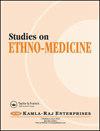Dracorhodin Content and Selected Bioactivities of Calamus ruber’ Dragon Blood Resin from Different Drying Conditions
Q2 Social Sciences
引用次数: 0
Abstract
Dragon blood resin from the fruit barks of Calamus ruber contains a bioactive compound, dracorhodin, that has many medicinal benefits. The study aimed to investigate the effects of different drying methods on dracorhodin content, cytotoxicity and antioxidant activities of the resin. Hot-air and hot-steam-air drying at 55°C and 60°C were employed in this study. Resin dried with the hot-steam-air drying at 55° was most toxic to Artemia salina (LC50 of 430.61 ppm). Resin dried with hot-steam-air drying at 60°C contained the highest dracorhodin content (4.34%) and was the best at scavenging DPPH• (1,1-diphenyl-2-picrylhydrazyl) (IC50 of 32.73 ppm), cupric ion (TEAC of 63.15 ppm) and ferric ion (TEAC of 8.73 ppm). Resin from the hot-air-drying at 55°C was the best at scavenging ABTS•+ (2,2’-azino-bis (3- ethylbenzothiazoline-6-sulfonic acid)) (TEAC of 469.72 ppm). Drying method and temperature affected the dracorhodin content and IC50 of the resin, respectively.不同干燥条件下菖蒲龙血树脂的龙血素含量及生物活性
从菖蒲橡胶的果皮中提取的龙血树脂含有一种生物活性化合物,龙血素,具有许多药用价值。研究了不同干燥方法对龙舌兰树脂中龙舌兰素含量、细胞毒性和抗氧化活性的影响。本研究采用55℃和60℃的热风和热蒸汽-空气干燥。55°热风干燥树脂对盐渍蒿的毒性最大,LC50为430.61 ppm。60℃热蒸汽-空气干燥的树脂中龙桃素含量最高(4.34%),对DPPH•(1,1-二苯基-2-苦味酰肼)(IC50为32.73 ppm)、铜离子(TEAC为63.15 ppm)和铁离子(TEAC为8.73 ppm)的清除效果最好。55℃热风干燥树脂对ABTS•+(2,2′-氮基-双(3-乙基苯并噻唑-6-磺酸))(TEAC为469.72 ppm)的清除效果最好。干燥方式和温度分别影响树脂的龙心素含量和IC50。
本文章由计算机程序翻译,如有差异,请以英文原文为准。
求助全文
约1分钟内获得全文
求助全文
来源期刊

Studies on Ethno-Medicine
Social Sciences-Cultural Studies
CiteScore
0.50
自引率
0.00%
发文量
13
期刊介绍:
Studies on Ethno-Medicine is a peer reviewed, internationally circulated journal. It publishes reports of original research, theoretical articles, timely reviews, brief communications, book reviews and other publications in the interdisciplinary field of ethno-medicine. The journal serves as a forum for physical, social and life scientists as well as for health professionals. The transdisciplinary areas covered by this journal include, but are not limited to, Physical Sciences, Anthropology, Sociology, Geography, Life Sciences, Environmental Sciences, Botany, Agriculture, Home Science, Zoology, Genetics, Biology, Medical Sciences, Public Health, Demography and Epidemiology. The journal publishes basic, applied and methodologically oriented research from all such areas. The journal is committed to prompt review, and priority publication is given to manuscripts with novel or timely findings, and to manuscript of unusual interest. Further, the manuscripts are categorised under three types, namely - Regular articles, Short Communications and Reviews. The researchers are invited to submit original papers in English (papers published elsewhere or under consideration elsewhere shall not be considered).
 求助内容:
求助内容: 应助结果提醒方式:
应助结果提醒方式:


